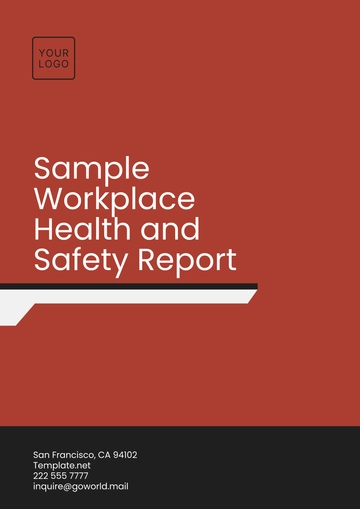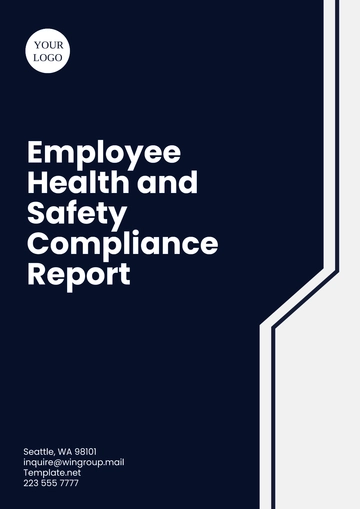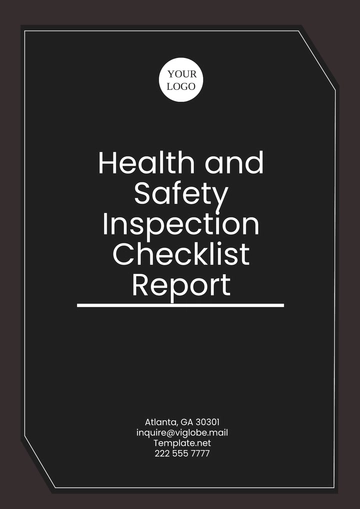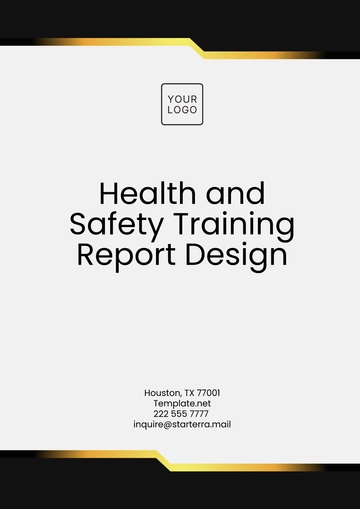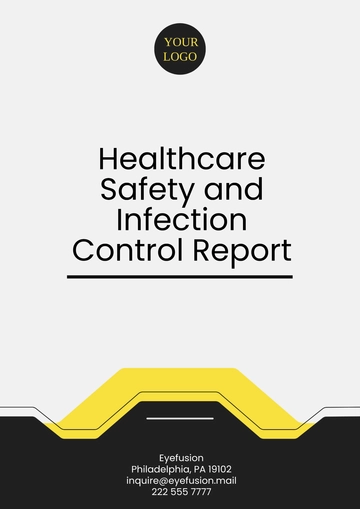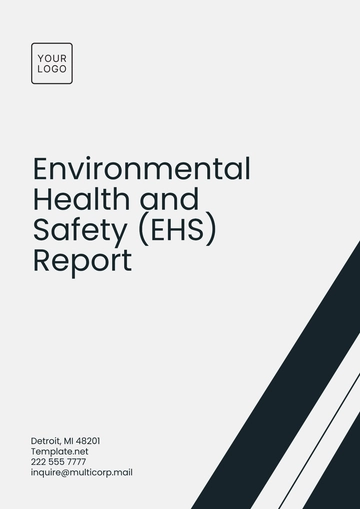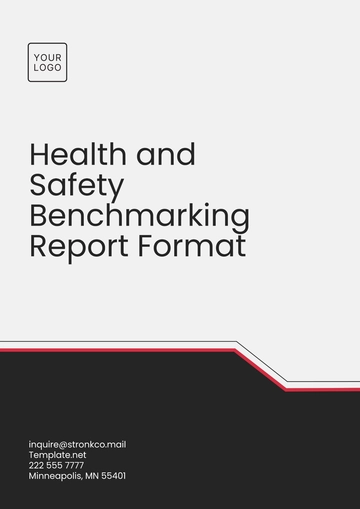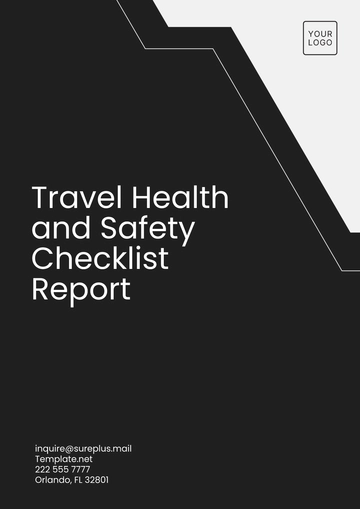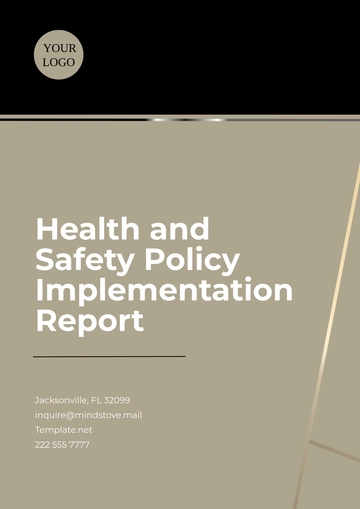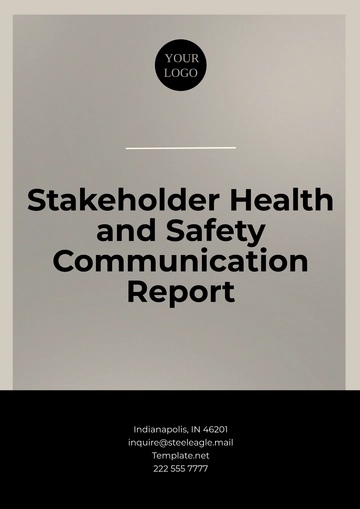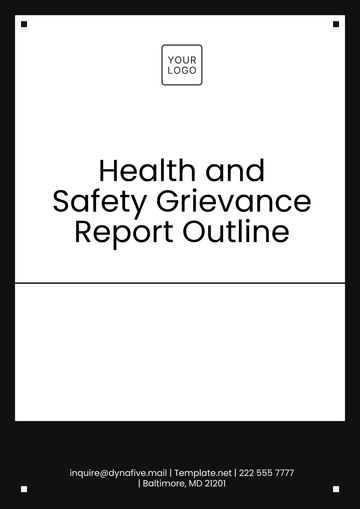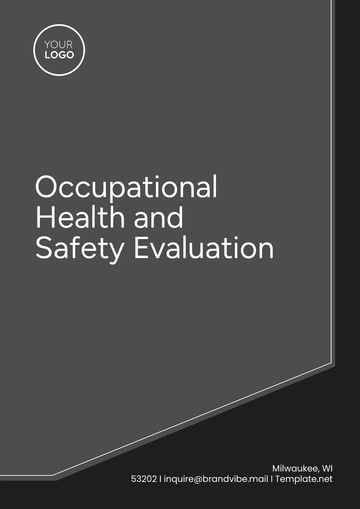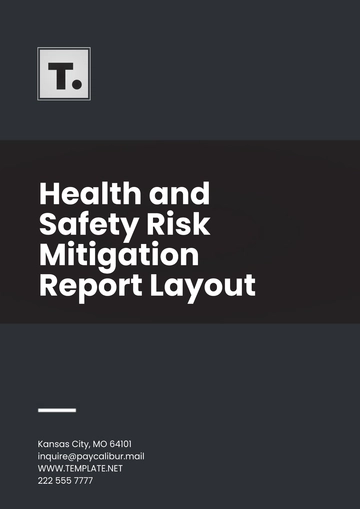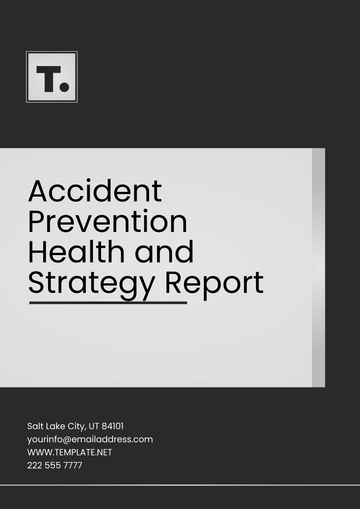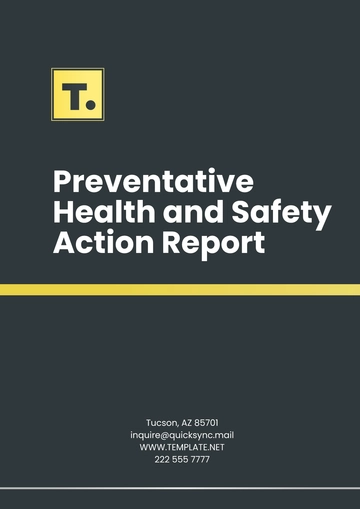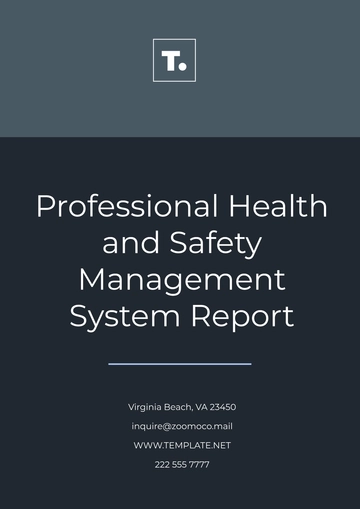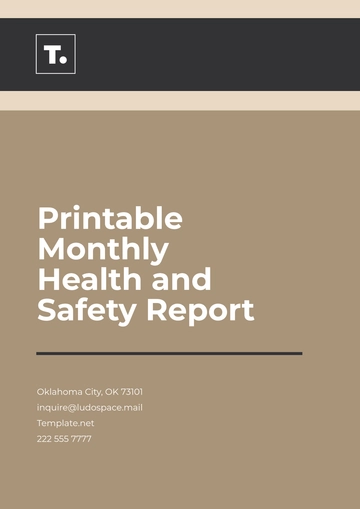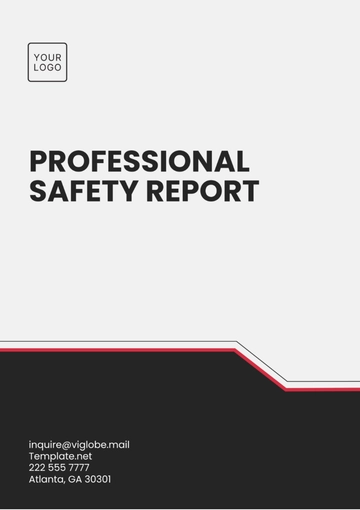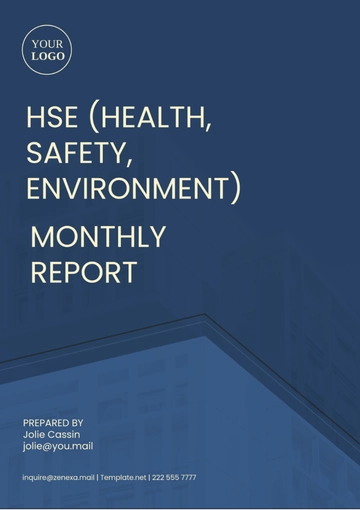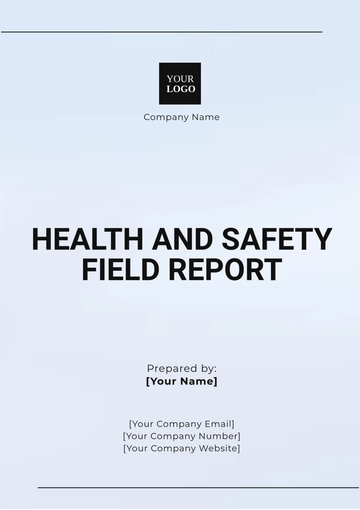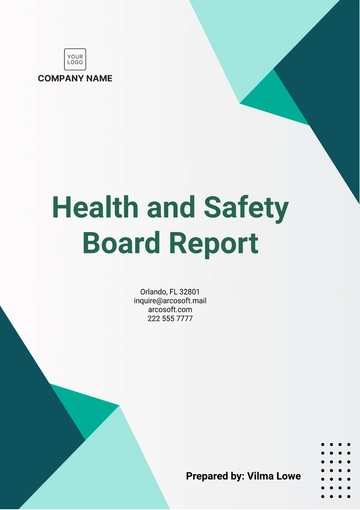Free Gym Safety Report

I. Introduction
A. Purpose
The purpose of this Safety Report is to provide a detailed account of the results of recent safety assessments conducted at [Your Company Name]. The purpose of the report is to meticulously identify various areas that require improvement, to systematically document any incidents that have occurred, and to recommend specific actions that can be taken in order to enhance and ensure the safety and well-being of everyone at the gym, including its members, staff, and visitors.
B. Scope
The scope of this report includes the evaluation of gym facilities, equipment, emergency procedures, and staff training programs. The document comprehensively encompasses detailed safety assessments that have been conducted over the span of the past six months. It includes a collection of data pertaining to incidents that have occurred during this period. Additionally, it provides an in-depth analysis of the current levels of compliance with established safety regulations. Furthermore, the document incorporates valuable feedback gathered from both gym members and staff, offering insights into their experiences and perceptions regarding the safety protocols in place.
C. Methodology
Safety Inspections: Thorough and methodical safety inspections were routinely carried out to meticulously assess and evaluate the current state and condition of all gym facilities, including the various equipment and amenities provided within the gym.
Incident Reports: Every incident was thoroughly documented, ensuring that all the details were meticulously recorded, and subsequently, these incidents were carefully analyzed in depth. The purpose of this detailed examination was to identify any discernible patterns or trends that might emerge from the data, as well as to pinpoint specific areas that could potentially benefit from improvement.
Member Surveys: A series of surveys were prepared and subsequently distributed to all members of the gym. The primary purpose of these surveys was to collect feedback from the members. This feedback specifically focused on understanding how the members perceived the overall safety within the gym environment. The goal was to gather detailed insights and opinions from the gym-goers regarding any safety concerns or commendations they might have.
Staff Training Assessments: The overall effectiveness of the staff training programs was thoroughly evaluated by conducting detailed observations of the training sessions and gathering comprehensive feedback from the participants who took part in these programs.
II. Safety Inspections
The following table summarizes the results of the recent safety inspections conducted at [Your Company Name]:
No. | Area Assessed | Findings | Actions Taken |
|---|---|---|---|
1 | Gym Equipment | 10% of equipment showed signs of wear | Replaced worn-out equipment |
2 | Emergency Exits | All exits were clear and accessible | No action needed |
3 | First Aid Supplies | 20% of supplies were expired | Replenished and updated supplies |
4 | Locker Rooms | Clean but need more frequent checks | Increased cleaning schedule |
5 | Fire Safety Equipment | All equipment was functional | Regular maintenance scheduled |
A. Gym Equipment
Condition of Equipment: The safety inspections revealed that 10% of the gym equipment showed signs of wear and tear. This included issues such as frayed cables, worn-out padding, and malfunctioning parts. Immediate action was taken to replace the affected equipment to ensure the safety of gym members.
Preventive Measures: To prevent similar issues in the future, a regular maintenance schedule has been established. This includes monthly inspections and prompt repairs or replacements of any equipment showing signs of deterioration.
B. Emergency Exits
Accessibility: The inspection confirmed that all emergency exits were clear and accessible. This ensures that members and staff can evacuate the premises quickly and safely in case of an emergency.
Signage: Clear and visible signage has been maintained at all emergency exits to guide members and staff during an evacuation. Regular checks are conducted to ensure the signs remain visible and unobstructed.
C. First Aid Supplies
Expiration of Supplies: The inspection revealed that 20% of the first aid supplies were expired. This poses a risk as outdated supplies may not be effective in treating injuries.
Restocking Efforts: All expired supplies were promptly replenished and updated. A new system has been implemented to monitor expiration dates and ensure supplies are regularly checked and replaced as needed.
D. Locker Rooms
Cleanliness: The locker rooms were found to be clean, but it was noted that more frequent checks are required to maintain this standard. This is especially important during peak hours when the usage is higher.
Improved Schedule: The cleaning schedule has been increased to ensure that locker rooms remain clean and hygienic at all times. Additional staff has been allocated during busy periods to maintain cleanliness.
E. Fire Safety Equipment
Functionality: The fire safety equipment was found to be functional and in good condition. This includes fire extinguishers, smoke detectors, and emergency lights.
Regular Maintenance: Regular maintenance has been scheduled to ensure that all fire safety equipment remains in working order. This includes monthly checks and annual professional inspections.
Ensuring that gym equipment is in good condition and emergency exits are accessible is crucial for the safety of all gym users. Regular inspections and maintenance help identify potential hazards before they lead to incidents, promoting a safer environment.
III. Incident Reports
The following table summarizes the incidents reported over the past six months:
No. | Date | Incident Description | Outcome |
|---|---|---|---|
1 | 01/15/2051 | Member slipped in the locker room | Improved locker room cleaning |
2 | 02/22/2051 | Minor injury from faulty equipment | Equipment replaced |
3 | 03/10/2051 | Fire alarm triggered by cooking class | Installed additional smoke detectors |
4 | 04/05/2051 | Member fainted during workout | Enhanced member health screening |
5 | 05/19/2051 | Child locked in bathroom | Installed child-friendly locks |
A. Member Slips
Incident Details: On January 15, 2051, a member slipped in the locker room due to wet floors. Fortunately, the member sustained only minor injuries, but this incident highlighted the need for improved cleaning protocols.
Actions Taken: The cleaning schedule for locker rooms has been increased to ensure floors are dry and safe. Additionally, non-slip mats have been installed to reduce the risk of slips and falls.
B. Equipment-Related Injuries
Incident Details: On February 22, 2051, a member suffered a minor injury from faulty equipment. The equipment was immediately taken out of service and replaced.
Actions Taken: The incident underscored the importance of regular equipment inspections. The maintenance team has been instructed to perform more frequent checks and promptly address any issues.
C. Fire Alarm Incidents
Incident Details: On March 10, 2051, the fire alarm was triggered by smoke from a cooking class. While there was no actual fire, the incident caused a brief evacuation and highlighted a potential issue with the sensitivity of smoke detectors.
Actions Taken: Additional smoke detectors were installed in the cooking area to prevent false alarms. The fire alarm system was also calibrated to reduce the likelihood of such incidents occurring in the future.
D. Health-Related Incidents
Incident Details: On April 5, 2051, a member fainted during a workout session. The member was quickly attended to by staff and recovered without any serious complications.
Actions Taken: This incident led to a review of member health screening procedures. Enhanced health screenings have been implemented to ensure that members are fit to engage in strenuous activities.
E. Child Safety Incidents
Incident Details: On May 19, 2051, a child was accidentally locked in a bathroom. The child was quickly rescued without harm, but the incident raised concerns about the safety of locks used in the facility.
Actions Taken: Child-friendly locks have been installed in all bathrooms to prevent such incidents in the future. Staff members have also been trained to respond swiftly to similar situations.
Documenting and analyzing incidents help in understanding common hazards and taking proactive measures to prevent future occurrences. Enhancing cleaning protocols and equipment maintenance are essential steps in improving overall safety.
IV. Member Surveys
The following table presents the results of the member safety surveys conducted:
No. | Survey Question | Positive Responses | Negative Responses |
|---|---|---|---|
1 | Do you feel safe using the gym equipment? | 85% | 15% |
2 | Are emergency exits clearly marked? | 90% | 10% |
3 | Is the locker room maintained clean? | 80% | 20% |
4 | Do you know the location of first aid kits? | 70% | 30% |
5 | Have you witnessed any safety incidents? | 20% | 80% |
A. Equipment Safety Perception
Survey Results: The survey results indicate that 85% of members feel safe using the gym equipment, while 15% expressed concerns. This feedback highlights the general satisfaction with the safety measures in place but also points to areas where improvements are needed.
Actions Taken: To address the concerns, additional safety instructions have been provided near equipment, and staff members are available to assist members in using equipment correctly.
B. Emergency Exits Awareness
Survey Results: An encouraging 90% of members reported that emergency exits are clearly marked. This high level of awareness is crucial for ensuring a swift evacuation during emergencies.
Actions Taken: To maintain and further improve this awareness, periodic reminders about emergency exit locations are included in member communications and during orientation sessions.
C. Locker Room Cleanliness
Survey Results: 80% of members reported satisfaction with the cleanliness of the locker rooms, while 20% indicated room for improvement.
Actions Taken: Cleaning protocols have been adjusted to ensure more frequent and thorough cleaning, particularly during peak hours, to maintain high hygiene standards.
D. First Aid Kit Awareness
Survey Results: 70% of members know the location of first aid kits, but 30% are unaware. This indicates a need for better visibility and communication regarding the location of these essential supplies.
Actions Taken: Additional signage has been placed around the gym to indicate the location of first aid kits, and members are informed about their locations during orientation sessions.
E. Witnessed Safety Incidents
Survey Results: Only 20% of members have witnessed safety incidents, indicating that the gym is generally a safe environment. However, 80% not witnessing incidents also means there is potential underreporting.
Actions Taken: Members are encouraged to report any incidents or near-misses they observe to help improve safety measures. Anonymous reporting options are available to ensure all incidents are documented.
Member feedback is invaluable in assessing the effectiveness of safety measures. Positive responses indicate that current practices are effective, while negative responses provide opportunities for targeted improvements.
V. Staff Training Assessments
The following table outlines the key findings from the staff training assessments:
No. | Training Program | Completion Rate | Feedback Score | Areas for Improvement |
|---|---|---|---|---|
1 | Basic First Aid | 95% | 85% | More practical sessions |
2 | Emergency Response | 90% | 80% | Regular refresher courses |
3 | Equipment Handling and Safety | 85% | 75% | Advanced equipment-specific training |
4 | Child Safety and Supervision | 88% | 78% | Scenario-based training sessions |
5 | Fire Safety and Evacuation | 92% | 82% | More frequent drills |
A. Basic First Aid
Training Effectiveness: The basic first aid training program had a high completion rate of 95% and received a feedback score of 85%. This indicates that staff members are well-versed in providing first aid.
Areas for Improvement: Feedback suggested that more practical sessions would enhance the effectiveness of the training. Practical experience is crucial in ensuring staff can confidently apply their skills in real-life situations.
B. Emergency Response
Training Effectiveness: The emergency response training program had a completion rate of 90% and a feedback score of 80%. This shows a strong foundation in emergency procedures among the staff.
Areas for Improvement: Regular refresher courses have been recommended to keep staff updated on the latest emergency response techniques and to reinforce their knowledge.
C. Equipment Handling and Safety
Training Effectiveness: This program had an 85% completion rate and a 75% feedback score, indicating a need for improvement in certain areas.
Areas for Improvement: Staff have requested advanced, equipment-specific training to better handle and maintain gym equipment. This would help prevent equipment-related injuries and improve overall safety.
D. Child Safety and Supervision
Training Effectiveness: With an 88% completion rate and a 78% feedback score, the child safety and supervision training is effective but has room for enhancement.
Areas for Improvement: Scenario-based training sessions have been recommended to better prepare staff for real-life situations involving children. This would improve their ability to handle emergencies and ensure child safety.
E. Fire Safety and Evacuation
Training Effectiveness: The fire safety and evacuation training program had a 92% completion rate and an 82% feedback score, showing strong preparedness among staff.
Areas for Improvement: More frequent fire drills have been suggested to ensure that all staff members are familiar with evacuation procedures and can act swiftly in case of a fire.
Staff training is a critical component of gym safety. High completion rates and positive feedback scores indicate that the current training programs are effective, but there is always room for improvement. By incorporating more practical and scenario-based training sessions, as well as regular refresher courses, [Your Company Name] can further enhance the skills and preparedness of its staff.
VI. Equipment Maintenance and Upgrades
The following table provides details on recent equipment maintenance and upgrades:
No. | Equipment Type | Maintenance Activity | Cost | Date Completed |
|---|---|---|---|---|
1 | Treadmills | Belt replacement | $1,200 | 03/15/2051 |
2 | Weight Machines | Cable inspection and repair | $800 | 04/10/2051 |
3 | Exercise Bikes | Pedal and seat adjustment | $600 | 05/05/2051 |
4 | Free Weights | Repainting and balancing | $500 | 06/01/2051 |
5 | Rowing Machines | Handle and chain replacement | $700 | 06/20/2051 |
A. Treadmills
Maintenance Activity: The belts of all treadmills were replaced on March 15, 2051. This was necessary to ensure the safety and functionality of the treadmills.
Cost: The total cost for the belt replacement was $1,200.
B. Weight Machines
Maintenance Activity: A thorough inspection and repair of cables on weight machines were conducted on April 10, 2051. This activity was crucial to prevent any cable-related accidents.
Cost: The cost for the cable inspection and repair was $800.
C. Exercise Bikes
Maintenance Activity: The pedals and seats of exercise bikes were adjusted on May 5, 2051, to ensure they are comfortable and safe for use.
Cost: The total cost for these adjustments was $600.
D. Free Weights
Maintenance Activity: Free weights were repainted and balanced on June 1, 2051, to maintain their usability and aesthetic appeal.
Cost: The cost for repainting and balancing was $500.
E. Rowing Machines
Maintenance Activity: The handles and chains of rowing machines were replaced on June 20, 2051, to ensure smooth operation and prevent wear and tear.
Cost: The cost for this replacement was $700.
Regular maintenance and timely upgrades of gym equipment are essential to ensure member safety and equipment longevity. By investing in these activities, [Your Company Name] demonstrates a commitment to providing a safe and high-quality fitness experience for its members. These proactive measures help prevent accidents and extend the lifespan of the equipment.
VII. Compliance with Safety Regulations
The following table summarizes the gym's compliance with relevant safety regulations:
No. | Regulation | Compliance Status | Actions Required |
|---|---|---|---|
1 | Fire Safety Code | Compliant | None |
2 | Occupational Safety and Health Act | Compliant | None |
3 | Health and Safety at Work Act | Partially Compliant | Additional training |
4 | Local Building Codes | Compliant | None |
5 | Electrical Safety Standards | Compliant | None |
A. Fire Safety Code Compliance
Compliance Status: The gym is fully compliant with the Fire Safety Code, ensuring that all fire safety measures are in place and regularly maintained.
Ongoing Efforts: Regular fire drills and equipment inspections are conducted to maintain this compliance and ensure readiness in case of an emergency.
B. Occupational Safety and Health Act Compliance
Compliance Status: The gym complies with the Occupational Safety and Health Act, which mandates safe working conditions for employees.
Ongoing Efforts: Continuous monitoring and improvement of workplace safety practices are carried out to uphold this compliance and protect staff and members.
C. Health and Safety at Work Act Compliance
Compliance Status: The gym is partially compliant with the Health and Safety at Work Act. While most safety measures are in place, additional training is needed for full compliance.
Actions Required: Staff will undergo additional training programs to address the gaps identified in the current safety practices and ensure full compliance.
D. Local Building Codes Compliance
Compliance Status: The gym is fully compliant with local building codes, which include structural safety, accessibility, and other essential standards.
Ongoing Efforts: Regular inspections are conducted to ensure ongoing compliance with these codes and to address any issues promptly.
E. Electrical Safety Standards Compliance
Compliance Status: The gym meets all electrical safety standards, ensuring that all electrical installations and equipment are safe and properly maintained.
Ongoing Efforts: Regular electrical inspections and maintenance are performed to maintain compliance and prevent electrical hazards.
Compliance with safety regulations is crucial for legal and ethical reasons. Adhering to these regulations not only protects the gym from potential legal issues but also ensures a safe and healthy environment for everyone. Continuous monitoring and improvement efforts are essential to maintain compliance and address any identified gaps promptly.
VIII. Recommendations
A. Enhancing Equipment Maintenance
Regular Inspections: Increase the frequency of equipment inspections to identify and address issues promptly. This will help maintain equipment safety and prevent accidents.
Maintenance Log: Implement a detailed maintenance log to track all maintenance activities and ensure timely repairs and replacements.
B. Improving Staff Training
Additional Training: Offer additional training programs focused on advanced first aid, emergency response, and handling specific types of equipment.
Feedback Mechanism: Establish a feedback mechanism for staff to share their training experiences and suggest improvements.
C. Increasing Member Awareness
Safety Orientation: Introduce a mandatory safety orientation for all new members to familiarize them with gym safety protocols and emergency procedures.
Regular Updates: Provide regular updates to members about any changes to safety protocols or equipment to keep them informed and engaged in maintaining a safe environment.
D. Enhancing Incident Reporting
Reporting System: Implement an easy-to-use incident reporting system that allows members and staff to report any safety concerns or incidents anonymously.
Data Analysis: Regularly analyze incident reports to identify patterns and take proactive measures to address recurring issues.
E. Maintaining Cleanliness and Hygiene
Cleaning Protocols: Review and enhance cleaning protocols to ensure high standards of hygiene, especially in high-traffic areas like locker rooms and restrooms.
Member Education: Educate members on the importance of personal hygiene and proper use of gym facilities to maintain a clean environment.
Implementing these recommendations will significantly enhance the overall safety of the gym. Regular maintenance, improved training, increased member awareness, efficient incident reporting, and strict cleanliness protocols are essential components of a comprehensive safety strategy. These proactive measures will not only reduce the risk of accidents but also create a safer and more welcoming environment for all gym users.
IX. Conclusion
The safety assessments conducted at [Your Company Name] have provided valuable insights into the current state of gym safety. While the gym is generally a safe environment, there are areas that require improvement to ensure the highest safety standards. By addressing the identified issues and implementing the recommended actions, the gym can enhance the safety and well-being of its members and staff.
Continued commitment to safety through regular inspections, staff training, member engagement, and compliance with regulations will create a safer and more enjoyable experience for everyone. The proactive measures outlined in this report will help maintain a secure and welcoming environment, reinforcing [Your Company Name]'s dedication to the health and safety of its community.
- 100% Customizable, free editor
- Access 1 Million+ Templates, photo’s & graphics
- Download or share as a template
- Click and replace photos, graphics, text, backgrounds
- Resize, crop, AI write & more
- Access advanced editor
Document safety assessments with the Gym Safety Report Template! Available on Template.net, this template is editable, allowing for easy customization to suit various safety reporting needs. It is designed to be customizable, ensuring it meets the requirements of your gym. Create a detailed safety report with our AI Editor Tool!
You may also like
- Sales Report
- Daily Report
- Project Report
- Business Report
- Weekly Report
- Incident Report
- Annual Report
- Report Layout
- Report Design
- Progress Report
- Marketing Report
- Company Report
- Monthly Report
- Audit Report
- Status Report
- School Report
- Reports Hr
- Management Report
- Project Status Report
- Handover Report
- Health And Safety Report
- Restaurant Report
- Construction Report
- Research Report
- Evaluation Report
- Investigation Report
- Employee Report
- Advertising Report
- Weekly Status Report
- Project Management Report
- Finance Report
- Service Report
- Technical Report
- Meeting Report
- Quarterly Report
- Inspection Report
- Medical Report
- Test Report
- Summary Report
- Inventory Report
- Valuation Report
- Operations Report
- Payroll Report
- Training Report
- Job Report
- Case Report
- Performance Report
- Board Report
- Internal Audit Report
- Student Report
- Monthly Management Report
- Small Business Report
- Accident Report
- Call Center Report
- Activity Report
- IT and Software Report
- Internship Report
- Visit Report
- Product Report
- Book Report
- Property Report
- Recruitment Report
- University Report
- Event Report
- SEO Report
- Conference Report
- Narrative Report
- Nursing Home Report
- Preschool Report
- Call Report
- Customer Report
- Employee Incident Report
- Accomplishment Report
- Social Media Report
- Work From Home Report
- Security Report
- Damage Report
- Quality Report
- Internal Report
- Nurse Report
- Real Estate Report
- Hotel Report
- Equipment Report
- Credit Report
- Field Report
- Non Profit Report
- Maintenance Report
- News Report
- Survey Report
- Executive Report
- Law Firm Report
- Advertising Agency Report
- Interior Design Report
- Travel Agency Report
- Stock Report
- Salon Report
- Bug Report
- Workplace Report
- Action Report
- Investor Report
- Cleaning Services Report
- Consulting Report
- Freelancer Report
- Site Visit Report
- Trip Report
- Classroom Observation Report
- Vehicle Report
- Final Report
- Software Report

